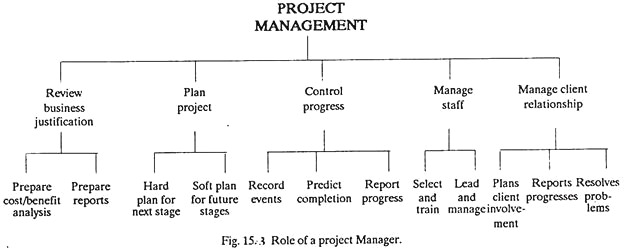After reading this article you will learn about:- 1. Meaning of Project 2. Types of Projects 3. Organisation 4. Cost Estimating and Budgeting 5. Planning and Scheduling 6. Controlling Progress and Costs.
Meaning of Project:
If there is one single quality which sets a project apart from routine commercial or industrial operations, it is its novelty. No two projects are ever exactly alike. A project is always a journey into the unknown, fraught with risk. Projects typically demand the use of resources that are scarce or expensive, but which have to be deployed over a most complex frame work of tasks.
Project Management:
The purpose of project management is to minimize, contain or counter the risks, and organize and direct the resources so that the project is finished in time, within budgeted costs and with the functional or other design objectives fulfilled.
If the purpose of project management is to meet the functional, cost and timescale objectives, then clearly these objectives must be properly defined from the outset. The technical or performance specification usually originates from a customer’s stated requirements. There must be in clear text the scope and technical performance of the project, supported by whatever drawings are necessary.
Since any eventual contract between the customer and the contractor will be based on this specification, it’ is important that no significant element of the project is omitted. After contract award, the sales specification becomes the definitive project specification. Project definition is a process which continues after contract award, right up to the final stages of commissioning.
Types of Projects:
(1) Manufacturing Projects:
Where the final result is a vehicle, ship, aircraft, a piece of machinery etc.
(2) Construction Projects:
Resulting in the erection of buildings, bridges, roads, tunnels etc. Mining and petro-chemical projects can be included in this group.
(3) Management Projects:
Which include the organization or reorganization of work without necessarily producing a tangible result. Examples would be the design and testing of a new computer software package, relocation of a company’s headquarters or the production of a stage show.
(4) Research Projects:
In which the objectives may be difficult to establish, and where the results are unpredictable.
Objectives of Project:
A project usually has three objectives:
(1) Function or Performance:
The final result must satisfy the requirements of the end user. Considering a project to develop a racing car, the objectives must be to produce a vehicle that satisfies specified standards for performance, Reliability and safety.
(2) Containment of Expenditure within Budget:
This is another criterion for project success. Continuing with the racing car development example, if the development costs were to exceed those planned, then their recovery from car sales could result in the selling price having to be increased too far above prices charged by competitors for their rival products. Projects must, therefore, be completed within their budgeted costs.
(3) Time Scale is the Third Factor:
In the motor car example, the car should be fully developed and proven in time for launch at the motor show.
Project Organisation:
Obviously the person at the head of the project (project manager; should, ideally, be technically experienced and qualified in the type of work involved. Note that there may be more than one project manager working on the same project. This has been seen in large projects with more than one participating contractor, or where subcontractors are employed.
Cost Estimating and Budgeting of Project:
Once the scope of a project has been defined clearly in a sales specification, it is necessary to estimate the likely costs of fulfilling all the work. Cost estimates form the basis of subsequent budgets for management control. They also provide a foundation for pricing.
Planning and Scheduling of Project:
Every project must be controlled from a plan of working. Ideally the promised project delivery or completion date will have resulted from careful planning. Large projects must be broken down in smaller packages or groups of tasks for the purpose of planning and control. This procedure should result in the identification of sub-projects that can be delegated to the responsibility of managers with relevant experience.
The next stage in project planning is to assemble all the tasks in a practical working sequence. This is possible for small projects using a Bar chart or with a Critical Path Network diagram. The critical path method provides an excellent notation for the purpose.
The addition of estimates for the duration of each task enables the planner to add up all the expected durations in the work sequence to arrive at a planned project completion date. A plan of action is not complete until the use of resources has been taken into account. This is the process of resource scheduling. Critical Path Analysis is a most powerful tool in this respect, because it allows a degree of criticality (float) to be assigned to each activity.
Controlling Progress and Costs of Project:
From time to time it is necessary to gauge Progress in terms of the value (cost) of work achieved. The contractor is required to submit regular report of progress to his client. Regular meetings may take place to review progress.
The purpose of such meet is to short-circuit the usual communication routes in an organization and get key people together so that progress data can be reviewed, disputes debated, and agreements reached on the spot. An essential in Cost control is to start with an approved budget, related item by item to each job or purchase, and with the timing of expenditure calculated to agree with the project work schedules.
When a project proceeds as per schedule, the costs will tend to take care of themselves. But if a project runs late, total costs will also overrun and there may also be expensive contractual penalties. Time is money!
